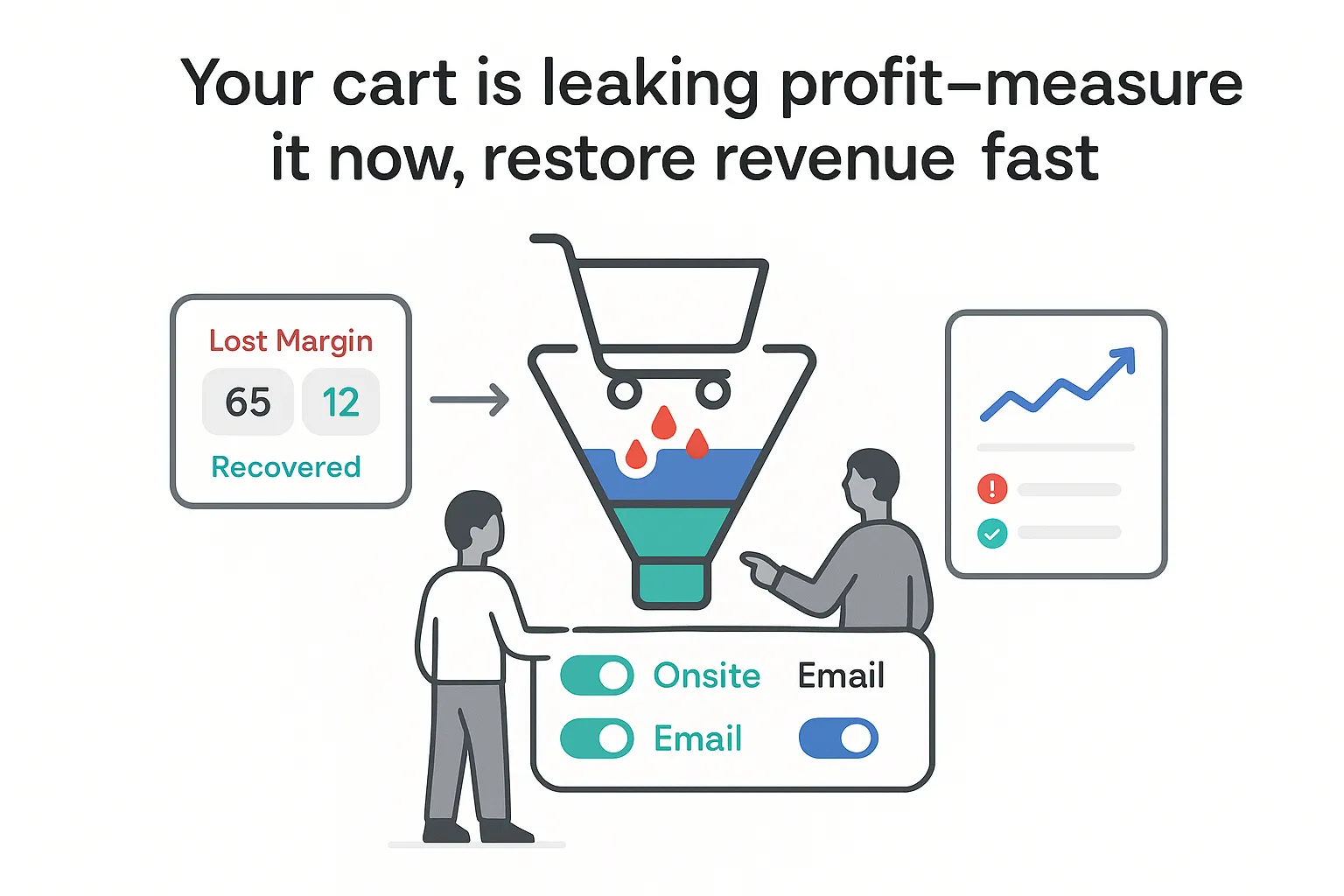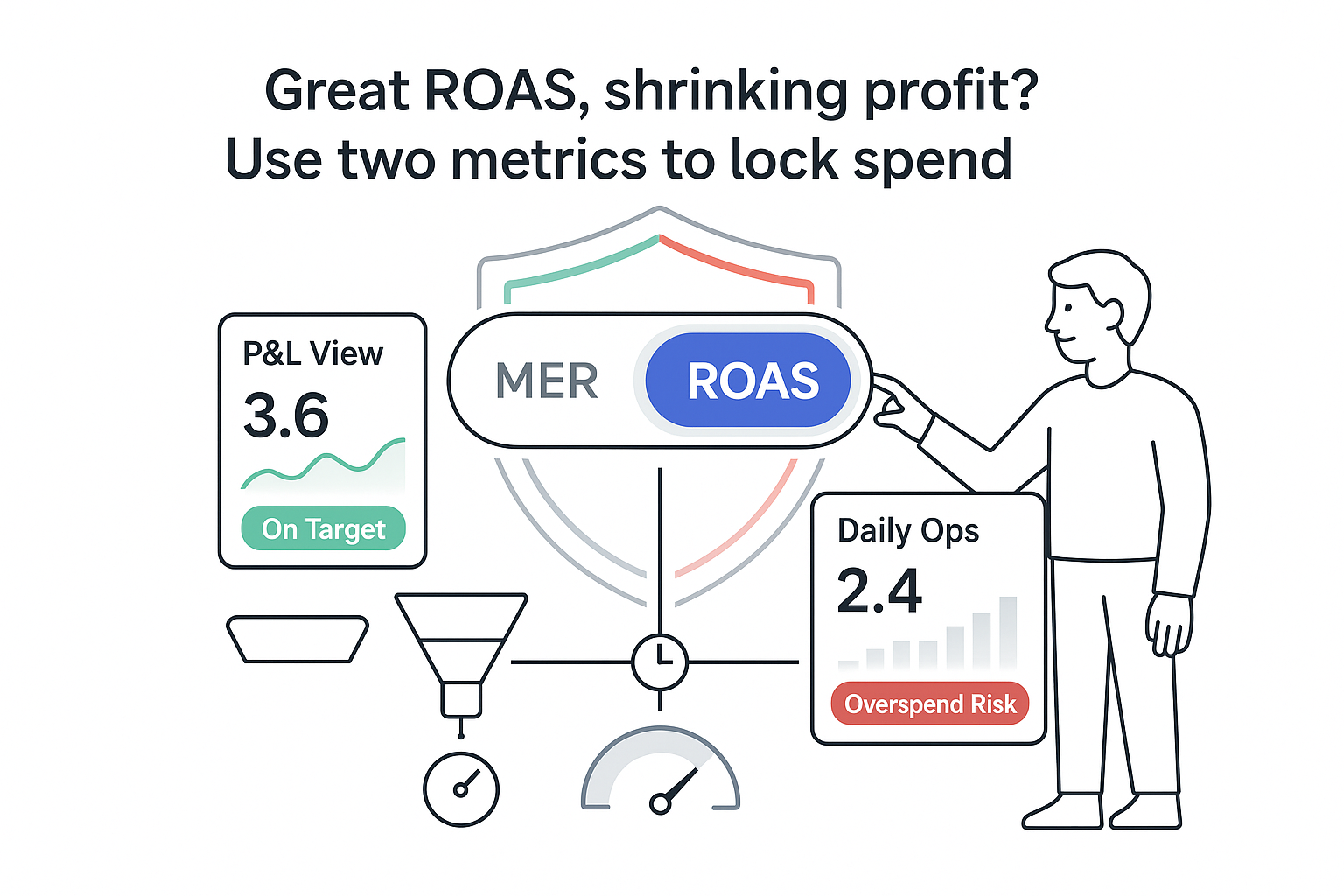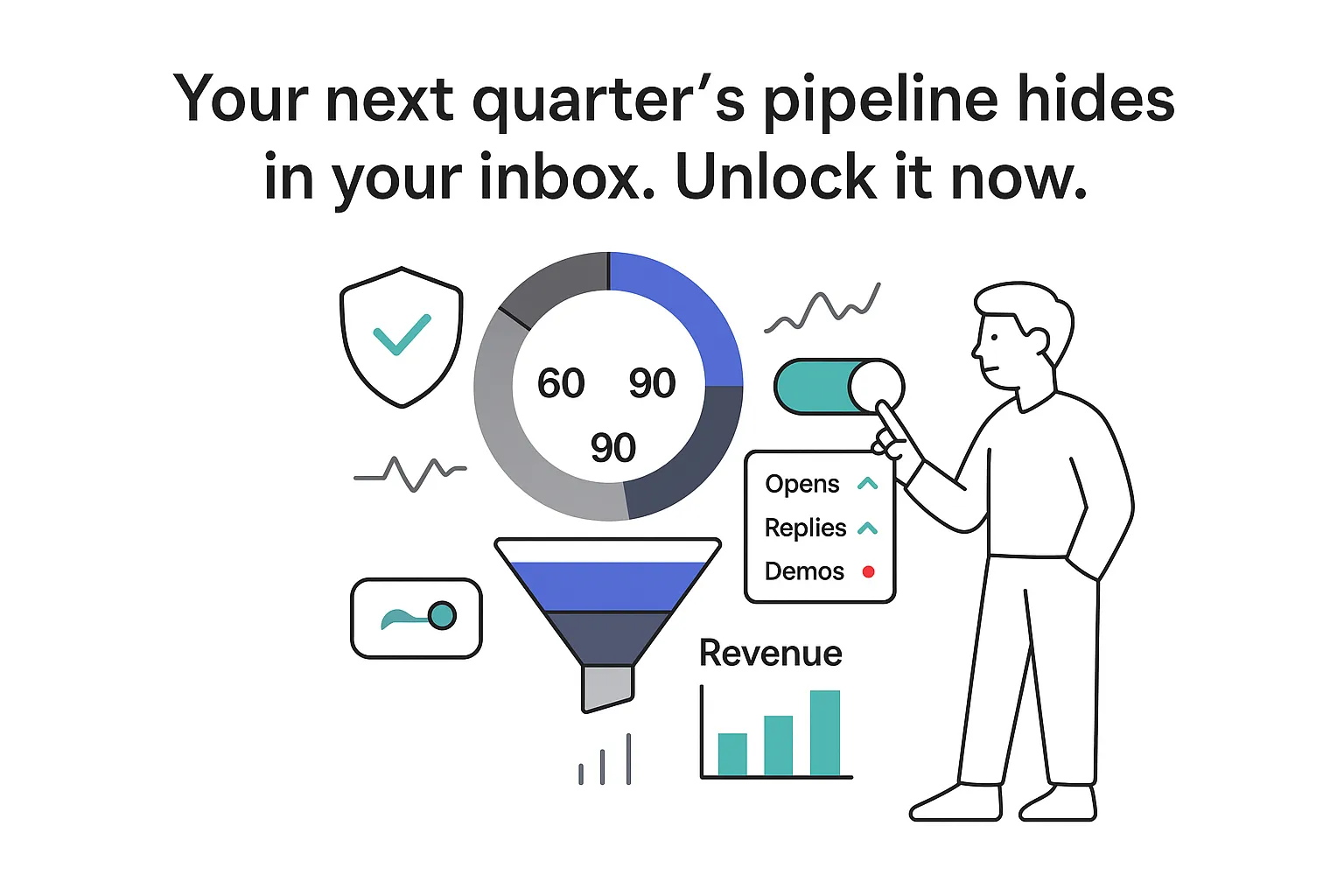You already pay for the traffic. The clicks arrive, people add to cart, and then... silence. If you run a B2B-leaning store or a service portal with checkout, I know that leak shows up fast in the numbers. The good news: shopping cart abandonment is not a black box. With a few focused moves, I can recover meaningful revenue without bloating the workload or training customers to wait for discounts.
For scale, the global average abandonment rate typically hovers just over 70% according to the Baymard Institute’s analysis. Even small reductions can add up to real dollars.
Abandoned cart recovery: size the upside, then act
I start with outcomes. A quick way to size the upside is a simple calculator you can run in a spreadsheet.
- Recoverable revenue per month = Carts created x Conversion gap x Average order value x Expected recovery rate x Gross margin
- Conversion gap = Current abandonment rate minus target abandonment rate (use decimals, not percentages)
- Expected recovery rate ranges I see most often:
- Email only: 5% to 12% of lost carts
- Onsite fixes plus email: 10% to 18%
- Onsite plus email plus retargeting: 12% to 22%
- Time to impact:
- Onsite fixes: same week once shipped
- Triggered emails: 7 to 14 days after launch
- Retargeting: 14 to 30 days to stabilize
Short example to make the math tangible:
- 10,000 carts created x 0.10 conversion gap x $120 AOV x 0.12 expected recovery x 0.45 margin ≈ $6,480 gross margin recovered per month. Your actual lift will vary with traffic quality, price points, and margins.
Three-part framework that keeps teams aligned and results measurable:
- Onsite fixes: reduce friction so fewer carts are lost in the first place. Think transparent costs, guest checkout, fast page loads, and modern wallets like Apple Pay and Google Pay.
- Triggered emails: send timely reminders that resolve objections and bring people back to finish checkout.
- Retargeting: reach people who did not click emails or who need more social proof with light-frequency ads on social and display.
Fast fixes executives notice
I prioritize changes that remove doubt and clicks:
- Expose total costs early. Show shipping and taxes before the last step. With many shoppers expecting free shipping, set thresholds thoughtfully (66% expect it).
- Enable guest checkout and one-tap wallets. Reducing steps and offering one-click style options improves completion (one-click purchasing).
- Add a progress bar and keep forms short. Simplify the checkout flow.
- Put live chat or a help link inside checkout, and staff it for fast replies (under a minute is a good target).
- Launch a three-email cart flow with dynamic product blocks and stop rules.
- Layer gentle retargeting to capture non-openers and non-clickers.
If seasonality matters, plan extra attention during Q4 and peak sale periods. Abandonment tends to spike on mobile when shipping cutoffs and delivery dates feel uncertain. Speed also matters: slower pages depress conversions, especially in the first few seconds of load (study).
What shopping cart abandonment really is (and why it happens)
Shopping cart abandonment is when a shopper adds items but leaves before paying. It hurts revenue and can mislead analytics if it is not measured cleanly. The reasons are usually simple and solvable.
Most common reasons:
- Unexpected costs like shipping, taxes, or fees late in the flow
- Forced account creation before checkout
- Slow, buggy, or multi-page checkout
- Payment failures or limited payment options
- Thin trust signals, unclear returns, or vague delivery timing
- Strict quantity or location restrictions revealed at the end
- Site speed issues and session timeouts
Mobile-specific friction worth addressing:
- Painful form fills on small screens
- Missing wallets such as Apple Pay or Google Pay
- Address entry without autocomplete
- Heavy images or scripts that stall on 4G
Did you know?
- The global average abandonment rate typically sits near 70%, and on mobile it often climbs past 80% (Baymard Institute’s analysis).
- Longer perceived delivery times and fees amplify drop-off. Shoppers often expect tight delivery windows, around 4.5 days or less.
- First impressions and trust signals matter. Design clarity and social proof influence purchase decisions (75% of consumers say a site’s look shapes credibility).
Abandoned cart email that actually performs
Email remains the highest-leverage recovery channel because it is owned, it reaches people while intent is warm, and it scales without extra media spend. In practice, I see abandoned cart emails attract strong engagement when the message is timely and relevant. Industry benchmarks often show high opens and solid clicks, though opens can be inflated by privacy features, so I treat clicks and conversions as the primary signal (Moosend’s 2025 database analysis).
How I make abandoned cart email work harder:
- Personalization that matters:
- Use dynamic product blocks with images, prices, and stock status.
- Greet the person by name and show the exact items left behind.
- Include last-viewed items if the cart is empty but interest was clear.
- Incentive strategy by tier:
- Tier 0: No discount. Lead with convenience, fast checkout, delivery dates, and social proof.
- Tier 1: Soft value. Free shipping threshold, loyalty points, or a small add-on.
- Tier 2: Modest discount when margins allow or when high-value carts stall.
- Guardrails: cap discounts by margin, exclude chronic bargain hunters, and avoid training repeat buyers to wait for emails.
- Trust builders that calm nerves:
- Reviews and star ratings for items in the cart
- Clear returns and refunds
- Secure checkout badges and recognizable payment methods
- Direct support access: live chat, phone, or a short help article (online payment security)
A clean three-email cadence covers most scenarios without audience fatigue.
- Email 1 at 1 hour: Gentle reminder and convenience pitch. Keep it short. Show the cart, mention delivery times, and make the primary button obvious.
- Email 2 at 24 hours: Handle objections. Address shipping, payment options, returns, and support. Add reviews or a small benefit if needed.
- Email 3 at 72 hours: Final nudge. If margins allow, include a limited perk. Reassure on timing and stock.
Stop rules:
- Stop when the person buys
- Stop if the cart changes meaningfully
- Respect unsubscribes and suppression lists
Segmentation tips that lift results:
- AOV tiers: treat high-value carts with concierge-style support and softer discounts
- First-time vs returning customers: returning may need less education
- Geography: call out local shipping speeds or restrictions
- Inventory: throttle discounts on items with low stock or thin margin
Subject line ideas:
- You left something great behind
- Ready when you are
- Still saving your cart
- Quick heads-up about your items
- Nearly there, two clicks to finish
- Want it by Friday? Order now to make the cutoff
Preview text ideas:
- Your items are still in stock
- Fast checkout, clear delivery dates
- Free shipping threshold is close
- Questions? I can help live
Primary button examples:
- Return to your cart
- Continue checkout
- Review your items
- Finish my order
I add UTM tags to keep reporting clean in analytics and to help paid teams build suppression audiences so we do not over-frequency the same people.
Set up and measure cart recovery without bloat
You do not need a giant build. A practical setup in your ESP can go live fast.
- Connect store data:
- Turn on tracking for add_to_cart, view_item, and begin_checkout events (server-side or client-side).
- Pass cart details and product feeds from your ecommerce platform to your ESP.
- Build dynamic content:
- Insert product blocks driven by the cart or last viewed items.
- Pull images, prices, and availability from your product feed.
- Configure triggers and timing:
- Trigger when begin_checkout fires without a purchase after 30–60 minutes.
- Add filters for cart value, geography, and inventory status.
- Add exclusions:
- Exclude buyers in the last 24 hours for the same cart
- Suppress recent unsubscribes and hard bounces
- Hold back VIP segments from discounts if margin is tight
- QA and test:
- Use test accounts to run through checkout and abandon at defined steps.
- Confirm dynamic blocks populate correctly on desktop and mobile.
- Validate links, coupon logic, and stop rules.
Tracking plan that aligns with revenue, not vanity:
- Click rate and conversion rate to gauge intent and performance (email analytics)
- Recovered orders and recovered revenue attributed to the flow
- Gross margin recovered after discounts and shipping
- Time to purchase after first email
- Unsubscribe rate and complaint rate to protect sender reputation
If you run ads, sync audiences across your ESP and ad platforms. Use checkout events in pixels or tags so you can suppress people who already returned through email. That avoids paying twice for the same recovery.
Track your cart abandonment rate and benchmark it
You can track abandonment with a simple formula.
- Cart abandonment rate = 1 − (Completed purchases ÷ Carts created) × 100
Example:
- If 2,700 purchases were completed out of 9,000 carts created, then 1 − (2,700 ÷ 9,000) = 0.7. Multiply by 100 to get a 70% abandonment rate.
Data sources and common pitfalls:
- Sources: ecommerce platform analytics, your analytics events, ESP logs for triggered flows, and your order system.
- Session vs user: analytics can overcount carts if a user starts multiple sessions. Prefer user-level or cart-ID-level analysis.
- Time windows: some buyers return after several days. Align lookback windows across tools.
- Duplicate events: guard against double-fire of add_to_cart or begin_checkout. Your ESP should ignore duplicates within a short time window.
- What counts as a cart: some sites add items to the cart on a product page. Others require a click into the cart. Define it once and keep it consistent.
Targets and trending:
- Track weekly and monthly.
- Aim for steady improvement, not perfection. A 2–5 point drop can be a six-figure gain at moderate volume.
- Segment your trend by device. Fixes on mobile often move the total rate more than desktop fixes.
Industry cart abandonment rates (broad reference points; sources such as Baymard and Statista report comparable ranges):
- Travel and hospitality: 80% to 85% overall, higher on mobile
- Luxury and jewelry: 78% to 83%
- Fashion and apparel: 75% to 80%
- General retail: 68% to 72%
- Food and beverage: 60% to 65%
- Grocery and consumer goods: 50% to 58%
- Pet care: 50% to 55%
- Digital subscriptions and B2B trials: wide range, often 65% to 80% based on trial design and payment timing
See Baymard Institute’s analysis and Statista’s 2025 data for deeper breakdowns.
Device delta:
- Mobile can run 10–15 points higher than desktop. If mobile is more than 20 points higher, prioritize wallets, form simplification, and speed.
How I use these reference points:
- If you sit above your sector by more than 5 points, start with onsite friction and payment options.
- If you sit near the average, focus on recovery channels and lift from email and retargeting.
- Revisit benchmarks during promotions and holidays since urgency changes behavior.
Three email examples to adapt
I map each approach to a common objection and test into the winner.
- Free shipping plus urgency
- Subject: Your cart qualifies for free shipping
- Preview: Quick checkout, delivery dates inside
- Body elements:
- Cart items with images and prices
- Free shipping badge and last day to reach the threshold
- Delivery date estimate based on location
- Primary button: Return to your cart
Why it works: reduces cost concerns and answers “when will it arrive.” Use when shipping fees are a common complaint and margins can handle the perk.
Testing ideas: threshold placement, badge color, delivery date phrasing.
- Helpful and trust-building
- Subject: Need a hand finishing your order
- Preview: Secure checkout and easy returns
- Body elements:
- Cart items plus star ratings
- Short line on returns and refunds
- Security logos and payments available (e.g., major cards and wallets)
- Support links for live chat and phone
- Primary button: Continue checkout
Why it works: handles the quiet fears that stall buyers. Use for first-time buyers or higher-consideration items.
Testing ideas: include one short FAQ, add a review snippet tied to an item in the cart.
- Playful and personality-driven
- Subject: Psst... your cart is feeling a little lonely
- Preview: I saved your picks
- Body elements:
- Big product images, maybe a fun line about stock levels
- Gentle reminder that the cart is saved for a limited time
- Primary button: Review your items
Why it works: light tone grabs attention and makes the brand feel human. Use when your audience responds to friendly copy and purchase risk is low.
Testing ideas: different humor levels and image styles; watch unsubscribes to keep it tasteful.
A few closing pointers that prevent headaches:
- I avoid over-discounting. I start with value messaging, then fold in perks only for segments that need them.
- I keep prices and perks consistent between email and checkout. Nothing breaks trust faster than mismatch.
- I measure recovered revenue with clear attribution. Crediting the last recovery touch within a seven-day window keeps finance comfortable with the math.
One last thought that sounds odd at first: not every cart should be recovered. If refunds climb after a certain discount or category, I pull back. Protecting margin and customer satisfaction beats a short-term pop. When the onsite flow is clean, the abandonment trend is moving down, and the emails are timely and respectful, recovery turns into a simple operating habit rather than a constant fire drill.







.svg)